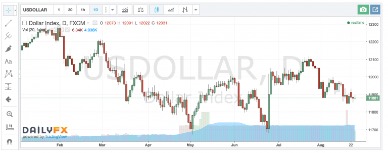
The disaggregated COT report is another one that is commonly known by traders. It provides a deeper breakdown of the market participants, splitting commercial traders into producers, merchants, processors, users, and swap dealers. The noncommercial participants are split between managed money and other reportables. It breaks down the open-interest positions of all major contracts that have more than 20 traders.

Green – Non Commercials – Speculators
Red – Commercials – Producers
This script is multi time-frame and… Before we dive into how to use the Commitment of Traders report as a forex trader, you have to first know WHERE to go to get the COT report and HOW to read it. Remember, since spot forex is traded over-the-counter (OTC), transactions do not pass through a centralized exchange like the Chicago Mercantile Exchange. These are institutional investors, including pension funds, endowments, insurance companies, mutual funds and those portfolio/investment managers whose clients are predominantly institutional. As we always say, never rely on one tool or indicator to decide your trades. As you can see, the currency pair just came from a downtrend and is making a reversal to the uptrend at about the same time.
How a Commitments of Traders (COT) Report Works, Types, Example
If commercial and non-commercial long positions are both growing, for example, that is a bullish signal for the price of the underlying commodity. The report provides investors with up-to-date information on futures market operations and increases the transparency of these complex exchanges. It is used by many futures traders as a market signal on which to trade.
EURUSD GBPUSD AUDUSD Commitment of traders report COT … – FOREX.com
EURUSD GBPUSD AUDUSD Commitment of traders report COT ….
Posted: Mon, 22 May 2023 07:00:00 GMT [source]
Before we discuss how to trade the forex market using the COT Report, you should know why the COT Report is important for forex traders. The specific number is not necessarily important, but rather a clear sign in percentage terms of open interest which makes it easy in identifying ‘Non-Commercials’ flipping against the primary trend. Furthermore, when a key flip in sentiment of ‘Non-Commercials’ is realized and there is a confirmation on the charts that a trend is exhausting, traders are likely trading in the same direction of the big kids. The long version of a COT report, in addition to the information in the short report, groups the data by crop year, where appropriate, and shows the concentration of positions held by the largest four and eight traders. Adam Hayes, Ph.D., CFA, is a financial writer with 15+ years Wall Street experience as a derivatives trader.
Learn more about trading with market sentiment
Besides his extensive derivative trading expertise, Adam is an expert in economics and behavioral finance. Adam received his master’s in economics from The New School for Social Research and his Ph.D. from the University of Wisconsin-Madison in sociology. He is a CFA charterholder as well as holding FINRA Series 7, 55 & 63 licenses. He currently researches and teaches economic sociology and the social studies of finance at the Hebrew University in Jerusalem. A COT Report Indicator that shows the Data for both currencies (base- and quotecurrency).
When there is a rise in the open interest of an asset, it means more people are trading the futures contract of the asset. The first place to start with is a clean understanding of ‘net positioning’ which is shown clearly on the report itself, as well as the week over week differential of major market bias (circled above). However, the original COT reports are text based and the CFTC does not provide any data analytics tools. This is meant to provide a clearer picture of what the people with skin in the game—the users of the actuals—think about the market versus the people with profit motivations or speculators.
How Do You Use a COT Report in Forex Trading?
The Commodity Futures Trading Commission (Commission or CFTC) publishes the Commitments of Traders (COT) reports to help the public understand market dynamics. Specifically, the COT reports provide a breakdown of each Tuesday’s open interest for futures and options on futures markets in which 20 or more traders hold positions equal to or above the reporting levels established by the CFTC. The CFTC releases the weekly COT reports in static format to support the historical usage patterns of industry professionals viewing and accessing each week’s data. Each historical report is viewable with the data for the respective reporting week, along with all historical data compressed within an annual file.
The category called “dealer/intermediary,” for instance, represents sellside participants. Typically, these are dealers and intermediaries that earn commissions on selling financial products, capturing bid/offer spreads and otherwise accommodating clients. The remaining three categories (“asset manager/institutional;” “leveraged funds;” and “other reportables”) represent the buy-side participants. These are essentially clients of the sell-side participants who use the markets to invest, hedge, manage risk, speculate or change the term structure or duration of their assets. The category called “dealer/intermediary,” for instance, represents sell-side participants.
Who are the non-commercial traders?
If you started trading in the last two decades, you’ve only known a world in which the euro is worth more than the US dollar. You’d have to go all the way back to 2002 to find data points representing the EUR/USD conversion rate that start with a zero to the left of the decimal point. If you are going to make sense of what is before you on the report, here are some terms you must understand. COT reports can be obtained from the CFTC website and can be downloaded in several file formats. By watching the behavior of these players, you’ll be able to foresee incoming changes in market sentiment.
- The number “non-reportable” positions is derived from subtracting the number of large spec and commercial positions from the total open interest.
- The report provides investors with up-to-date information on futures market operations and increases the transparency of these complex exchanges.
- To use the COT Report as a volume indicator, keep your eyes on the open interest numbers of an asset.
- And if you need to check the weekly reports in a particular month, use the Historical Viewable section of the website.
These positions can be easily tracked due to the margin they must pay to hold their large positions which the CFTC has been publishing since 1962. COT reports are used by many speculative traders to help making decisions on whether to take a long or short position. Traders can use the report to help them determine which positions they should take in their trades, whether that’s a short or a long position. One thing the report does not do is categorize individual traders’ positions because of legal restraints. This is part of confidential business practices, according to the commission. Due to legal restraints (CEA Section 8 data and confidential business practices), the CFTC does not publish information on how individual traders are classified in the COT reports.
The table shows the Net-Contracts, Long and Short Percentage of the latest report. The line chart shows if the Commercials, Institutionals and Retail Traders are more long biased (value above 50) or more short biased… The legacy COT report separates reportable traders only into “commercial” and “non-commercial” categories. The long report, in addition to the information in the short report, groups the data by crop year, where appropriate, and shows the concentration of positions held by the largest four and eight traders.
This group of traders is generally thought to be small speculators and hedgers who are not holding a position large enough to report to the CFTC. The Commodity Futures Trading Commission (CFTC) COT report offers a unique look at the positioning of futures https://g-markets.net/ traders across a broad range of markets, and it is quite often used as a proxy for the FX trading market. In the weekly report, the US regulator breaks down long and short positions and overall open interest according to three separate trading groups.
To get better results, you can use the data from the COT report to complement your technical analysis from other forex trading tools. The COT report can serve as a powerful forex volume indicator when you use it rightly. Since CFTC releases the weekly report every Friday for all trades recorded before Tuesday, you can only use it for long-term commitment of traders forex trades. Upon the first reading of the COT report, it may seem confusing how future positions in USD, JPY, GBP or EUR could be helpful for trading EUR/USD, USD/JPY, or EUR/GBP. There is a lot to learn about the COT report but what’s often helpful is to find where there is a strong divergence between large speculators and large commercials.
Knowing where traders’ positions are in the forex market can be valuable information when constructing trade ideas. The Commitment of Traders (COT) reports provide a breakdown of each Tuesday’s open interest for markets in which 20 or more traders hold positions equal to or above the reporting levels established by the CFTC. One exception we have noted recently is the ability of the small trader in T-bonds to hit the correct direction of the market. It is also important that the COT report with futures and options (released one day later) confirm the situation that is indicated by the futures only report. Non-reportable traders don’t have the heavy bank accounts of commercial and non-commercial traders. They are speculators with smaller accounts who are also looking to make money from the futures market.
So, when you find that their positions on a certain futures contract are reversing, and a reversal might be imminent on the underlying asset. This use of the COT report is similar to how you might use a sentiment indicator, such as the Current Ratio FXSSI indicator, in a forex sentiment analysis. The other method involves noting where the non-commercial traders are accumulating their positions. Remember that non-commercial traders are the big money guys that are interested in making more money. So, it is difficult to accurately track the volumes behind all forex trades.
While the position data is supplied by reporting firms, the actual trader category or classification is based on the predominant business purpose self-reported by traders on the CFTC. References to over-the-counter (“OTC”) products or swaps are made on behalf of StoneX Markets LLC (“SXM”), a member of the National Futures Association (“NFA”) and provisionally registered with the U.S. SXM’s products are designed only for individuals or firms who qualify under CFTC rules as an ‘Eligible Contract Participant’ (“ECP”) and who have been accepted as customers of SXM. StoneX Financial Inc. (“SFI”) is a member of FINRA/NFA/SIPC and registered with the MSRB. Securities and Exchange Commission (“SEC”) as a Broker-Dealer and with the CFTC as a Futures Commission Merchant and Commodity Trading Adviser.

